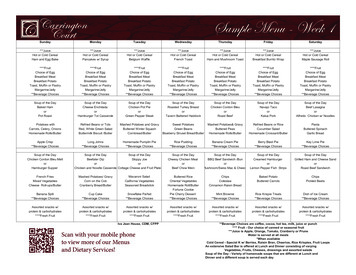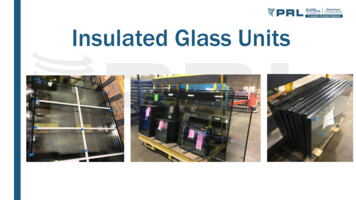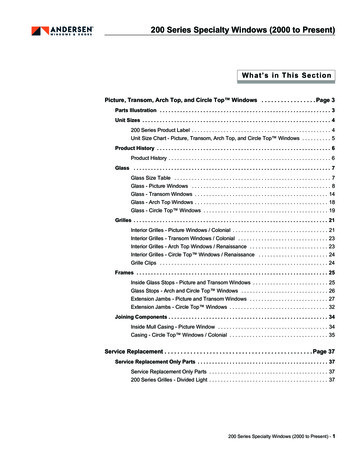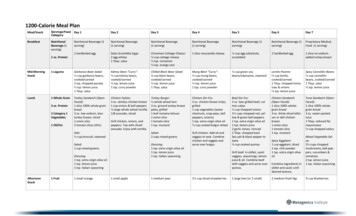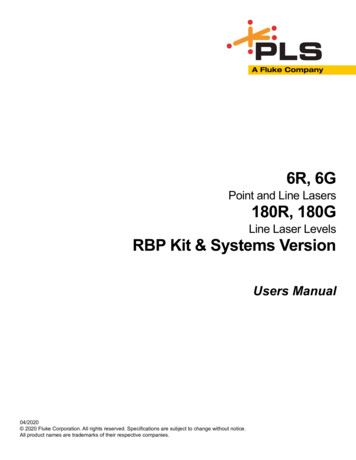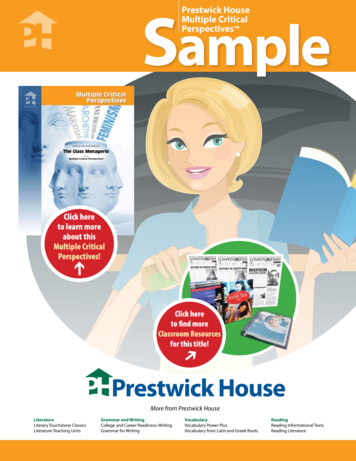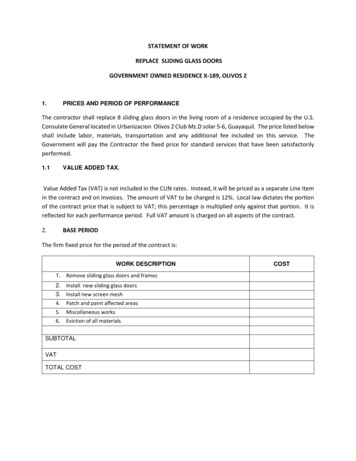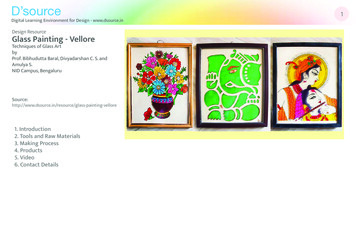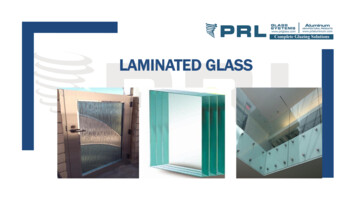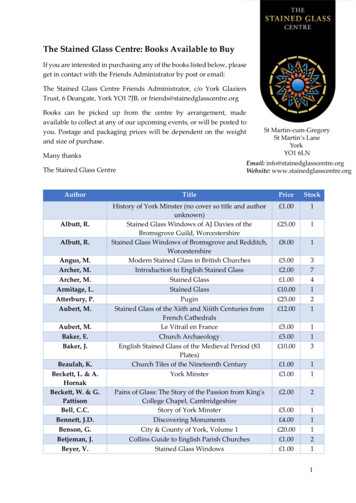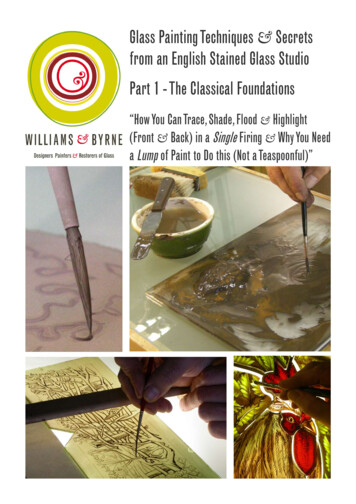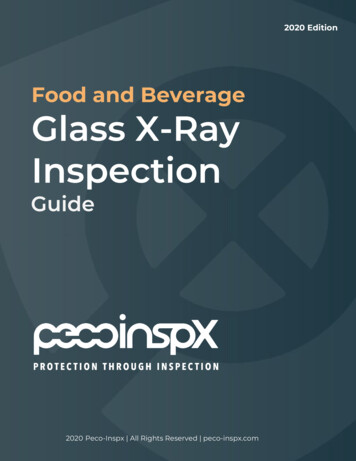
Transcription
2020 EditionFood and BeverageGlass X-RayInspection2020 Peco-Inspx All Rights Reserved peco-inspx.com
Table of ContentsAdvantagesBasic MechanicsSpecific ChallengesBest PracticesMinimizing False RejectsState-of-the-Art EquipmentSHIELD TrioSHIELD Glissando/Glissando PlusChoosing the Right ProviderConclusionAbout Peco-InspXFood and Beverage Glass X-Ray Inspection Guide 2020 Peco-Inspx Inc. All Rights Reserved
AdvantagesNo other packaging material has all the advantages of glass:unrivaled clarity; wide varieties; reusable, cost-effective,environmentally-friendly. According to a report by The Atlantic,“Glass has changed the world like no other substance .withoutglass, the world would be unrecognizable”. In the E.U. alone, atotal of 20.9 million tonnes of glass was used for food andbeverage packaging (a 2,9% increase from the year before).Food and Beverage Glass X-Ray Inspection Guide 2020 Peco-Inspx Inc. All Rights Reserved
AdvantagesAll this to say: glass use is growing. And it will likely continue togrow as society becomes sick of the recycling challenges andenvironmental impact of plastic. According to a survey of over4,000 consumers conducted by research group EcoFocusWorldwide, 37% of consumers said they were extremely or veryconcerned about the health of safety of plastic use in food andbeverage packaging.When it comes to manufacturers, there are two main reasonsthat glass is favored:1.2.the consumer assumption that things in glass are betterproductsthe perception from consumers that glass is inert – that iswhy you find baby food in glassFood and Beverage Glass X-Ray Inspection Guide 2020 Peco-Inspx Inc. All Rights Reserved
AdvantagesWhile glass has a host of consumer benefits, it also poses somereal challenges in container manufacturing and food andbeverage operations: defects. During manufacturing, glasscontainers can incur a host of defects that are serious food safetyrisks – including material cracks, chips, wall inclusions. and moreesoteric defects like bird swings. Dangerous glass shards can beaccidentally introduced to containers during operations. Becauseof this risk, every glass container should be inspected.Food and Beverage Glass X-Ray Inspection Guide 2020 Peco-Inspx Inc. All Rights Reserved
AdvantagesNot inspecting, or insufficient inspection, can result incontaminated or defective products, which can lead to recalls.Recalls are expensive, time-consuming, and damage brand trustbetween company and customer. But they can be avoided withglass X-ray inspection.Food and Beverage Glass X-Ray Inspection Guide 2020 Peco-Inspx Inc. All Rights Reserved
Basic MechanicsThe fact that X-ray inspection can find glass fragments within aglass container may be surprising – but it’s actually routine.Finding these glass fragments in glass bottles is possiblebecause:: Glass has sufficient enough density that the addedthickness in the image of the extra glass particles ismaterial enough to be seen.The specific gravity of glass particles in the product differsmaterially from that of food or beverage products, whichhave a specific gravity close to 1.Soda lime glass, which is the material most glasscontainers are made with, has a specific gravity of 2.48Understanding the specificgravityofyourglasscontainers is critical toensuringthatchallengesamples used to testing willactually capture expectedreal-workinspectionperformance.7
Basic MechanicsModern glass inspection techniques use Empty BottleInspector (EBI) to inspect glass containers before filling. Then, aFull Bottle Inspector (FBI) will X-ray filled glass containers.EBIs use”vision technology” to ensure that there are no exteriorfinish defects in the container, and to verify that the interior isfree from foreign material.FBIs focus solely on detecting foreign material. Ideally, FBIs areused immediately after the filling and closure process. Thisensures that in the event of the filler or the capper damagingthe containers, the least amount of defective containers areproduced before the problem is resolved.8
Specific ChallengesCompared to other forms of food and beverage X-ray inspection,“glass container inspection” has a unique set of challenges: Glass containers widely vary in container dimensions, which isdirectly attributed to the manufacturing process. Each moldused in the manufacturing process is unique, and so there areconsiderable mold-to-mold variations in the finished container. Detecting small contaminants in glass containers that are thesame density of the container (e.g., detecting a glass shard in aglass bottle) requires significantly more inspection sensitivitythan other applications.High resolution X-ray image of aglass 12 oz beer bottle showing 1.5mm (3) shards in the bottomFood and Beverage Glass X-Ray Inspection Guide 2020 Peco-Inspx Inc. All Rights Reserved
Specific Challenges Punts, or “push ups”, are typical in glass containers,whichcanobstructX-rayimaging Contaminants also tend to rest in the “push up”, thespace between the punt and container exterior wall,which can make them more difficult to find. Glass shards are, by definition, asymmetric objects –one dimension of the shard is very small. Reliablydetecting these types of contaminants requires moresophisticated multi-beam imaging systems.10
Specific Challenges Thicker walls on glass bottles can also require high levelsof X-ray power, risking “image wash-out” ofcontaminants during an inspection Speed: Glass lines can operate as fast as 1,300 containersper minute; therefore, inspection and rejectionequipment must be extremely fast (and yet not breakthe container during the inspection process).11
Best Practices Developing Strong Image ResolutionPerhaps the most critical element of glass containerinspection is to take extremely high contrast X-ray imagesthat clearly show the defects. Manufacturers use a variety oftechnical approaches to maximize image quality; includingvery high contrast X-ray sources and very short distancesbetween the X-ray source and detector. The results of theseefforts are very easy to see in an actual X-ray image – pieces offoreign glass material are clear.Additionally, because glass containers are generally taller thanthey are wide, a side-view X-ray inspection architecture willproduce the best inspection. Side-view glass systems alsohave more powerful imaging sources, which allows them tomore properly expose glass containers.X-ray beam 1X-ray beam 2X-ray beam 3Three views of x-rayimages of a glasscontainer with a glasssplinter contaminant.12
Best Practices Multiple Beam X-ray Inspection for GlassMultiple beam X-ray systems are critical for inspection glasscontainers for three reasons:1.Asymmetric glass shards are best detected using multiplebeam system. The container walls usually have a thindimension; and the lengthwise dimension is slightly larger.This means that single-beam X-rays may not being able todetect a shard from every direction.2.They leverage various imaging geometries, which omponents.3.Theyarecriticalinimaging around the puntin the bottom of thecontainer. The extra glassforming the push upreduces imaging and sospecial techniques areneeded to address thisshortcoming.13
Best Practices Challenge Test with Correct Density Test PiecesIt’s exceptionally important to ensure that test pieces used forchallenge tests are the appropriate density. In the X-ray industry,there is a wide use of test results using “high mineral glass”,which has a specific gravity much greater than soda lime glass.While the detection of high mineral glass can be impressive,high mineral glass is not naturally occurring in any food andbeverage production environment – and so test results fromhigh mineral glass are meaningless.Challenge testing for glass applications must be done usingType P or Type M soda lime glass. These test pieces mostaccurately represent the type of glass used in glass containerconstruction, and so test results will most closely replicate actualshard detection performance.14
Best Practices TraceabilityOne of the inherent benefits of using X-ray inspection technologyis traceability. An image of a container is generated and stored; if acontaminant is reported, the X-ray image can be reviewed –“traced back” – to determine if the contaminant was present atthe time of inspection.15
Minimizing False RejectsSince there can be considerable variations in dimensions fromcontainer to container, sophisticated inspection software isrequired to ensure the variations do not cause false rejects.In the most basic sense: the software needs to remove thecontainer walls from the image and determine if any of theremaining image has contaminants in it. While conceptuallysimple, this is a complex process, requiring sophisticated softwareengineering.Good false reject performance on glass containers is 4 falserejects per 10,000 inspected containers. Peco-InspX is developingapproaches that will reduce the false reject rate to 1 per 100,000inspected containers.16
State-of-the-Art EquipmentPeco InspX offers two types of inspection systems1.2.SHIELD Trio SeriesSHIELD Glissando ServicesBoth systems are state-of-the-art X-ray tools for inspectingglass containers that are designed for specific applications.Trio vs. Glissando: Real World PerformanceTrioGlissandoSize of ContainersStandardStandard & OversizedStainless Steel Sphere1.5mm.8mmSoda Lime Glass Sphere3.5mm3.0mm (2.5mm @ 90%)17
SHIELD TrioThe SHIELD Trio is a unique triple beam glass inspectionsystem – it uses a single 600W X-ray tube to obtain 3 distinctX-ray beams, making the Trio much less expensive to ownthan competing X-ray designs.The triple beam design offers superior detection ofasymmetric glass shards as each container is imaged 3 timesfrom distinct geometries. This design is fundamental to“seeing around the dimensions of the push up” in the bottomof the container.18
SHIELD TrioAdditionally, the Trio has a center beam that is perfectlyperpendicular to the container, which allows for extremelyaccurate fill height and headspace measurement.Because the Trio sits over the customer’s existing container, itis completer non-contact and requires no container transfers;which makes adding the Trio to existing plant operations easy.However, the Trio does require approximately 0.5 containerdiameter spacing between successive containers to preventimage overlapping during the inspection process.The SHIELD Trio from Peco InspX19
SHIELD GlissandoThe SHIELD Glissando uses a different inspection architecturethan the Trio that images from the top through the bottom ofthe container – this allows the machines to see directly over thecontainer punt.To provide multi-geometry inspection, the machine hasapproximately a 12 degree separation between the twindetectors imaging the bottom of the container, which areimaged using a single X-ray source.The SHIELD Glissando from Peco InspX20
SHIELD GlissandoBecause the Glissando images through the bottom of thecontainer (where there tends to be less container variationthan in the sides), the Glissando series tends to achieve betterinspection performance than the SHIELD Trio. However, thisimprovement does come with some operational expense.Unlike the Trio, the Glissando requires that containers betransferred onto the machine’s internal conveyor (whereas theTrio sits directly over the customer’s conveyor). The Glissandoconveyor uses a special high-tech belting material to aid in thecontainer transfer and to ensure maximum imagingperformance through the bottom of the container.The Glissando architecture does not require spacing betweenadjacent containers. In fact, back-to-back containers can beliterally touching.TheGlissandoarchitecturedoes not require spacingbetween adjacent containers.In fact, back-to-back containerscan be literally touching.21
SHIELD Glissando PlusThe Glissando series is also available in a large containerformat system called the “Glissando Plus”. The Glissando Plusis the only X-ray inspection system on the market that cancompletely image a U.S. gallon-sized glass container.To image these containers, the Plus adds a secondary beamthat is mounted on an electrically-adjustable track – so thatthe beam can be optimally positioned. The twin X-ray sourcesgive the Glissando Plus 1200 watts of X-ray power, making itthe most powerful food and beverage X-ray inspectionsystem on the market.22
Choosing the Right GlassInspection ProviderDue to the complexities of glass inspection, working with aknowledgeable and experienced provider is critical to achievingthe best results. So when purchasing a glass inspection system,it is important to understand: The design of the provider’s systemsTheir knowledge base of glass inspectionA good inspection provider can work with your glass supplier toimprove the quality of your glass containers in addition toensuring the root cause of any contamination that happensduring the production process.When deciding to invest in glass inspection X-ray technology,think of it as a partnership rather than a one-time purchase. Ifcomplications arise, your partner must confidently provide asolution.If you’re interested in ademo of how Peco-Inspxcanhelpyourglassinspection process, watchour full product demo videoand fill out the form on thispage.23
ConclusionGlass container inspection comes with a unique set of challenges,so it is critical to invest in a machine that is able to overcomethem. Besides offering the highest probabilities for detectingcontaminants and flaws, the ScanTrac Trio goes above andbeyond by providing other precise inspection criteria such as lidpresence and fill level. The Shield Glissando takes glass inspectionperformance even further by offering the best combination ofspeed and detection ability.Food and Beverage Glass X-Ray Inspection Guide 2020 Peco-Inspx Inc. All Rights Reserved
About Peco-InspXAbout Peco-InspxPeco-InspX Corporation is a leading provider of advancedtechnology inspection solutions for the food and beverageindustries. With headquarters in Silicon Valley (San Carlos), CAand European headquarters in Nuneaton, UK, the companyserves customers around the world and inspects over 120 millionfood and beverage containers daily. The company specializes inaccurate high-speed package inspection in machines that areeasy-to-use with a low cost of ownership. More info athttp://www.peco-inspx.com.Customers worldwide that trust Peco-InspxFood and Beverage Glass X-Ray Inspection Guide 2020 Peco-Inspx Inc. All Rights Reserved
system - it uses a single 600W X-ray tube to obtain 3 distinct X-ray beams, making the Trio much less expensive to own than competing X-ray designs. The triple beam design offers superior detection of asymmetric glass shards as each container is imaged 3 times from distinct geometries. This design is fundamental to
